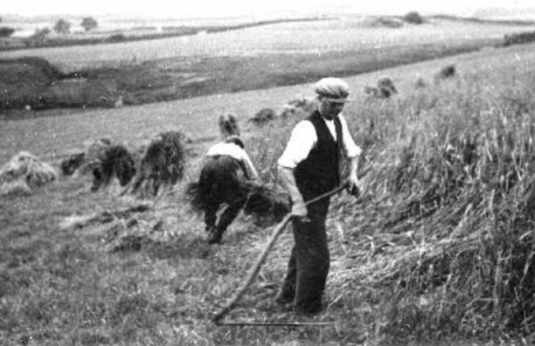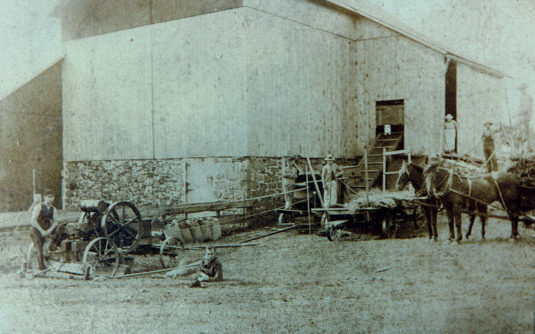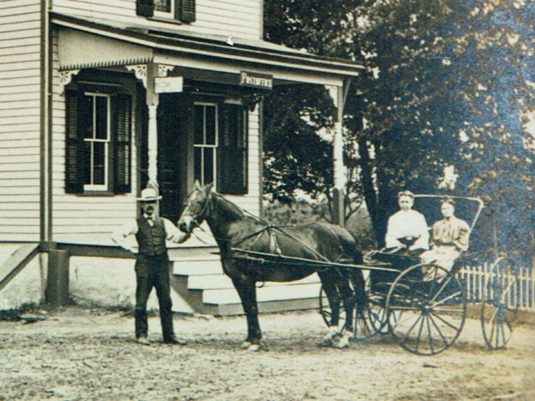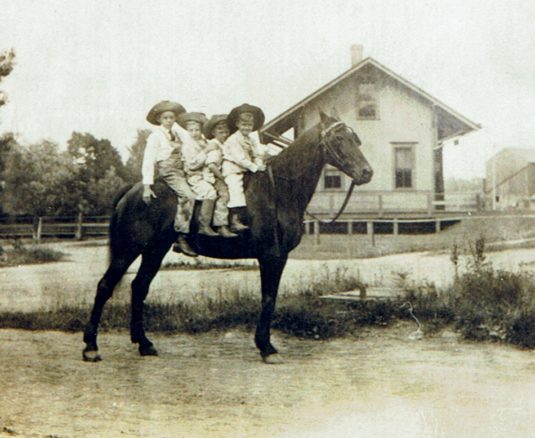After November’s big snowstorm, when so many people trying to drive home found themselves in crashes or stuck in a ditch, I began to wonder what sort of trouble people got into back in the last half of the 19th century. Luckily for me, I had Bill Hartman’s abstract of the Hunterdon Republican, 1856-1900, to turn to. With his abstracts collected into one pdf file, it was easy to search on a word like “accidents.” I found quite a few of them.
And yet, all those accidents were only a fraction of the total number. There was a great difference between actual events and items that showed up in the newspaper. Bill Hartman found that there were 293 deaths in Hunterdon County in 1870, but only 90 were reported in the Republican. There were 247 marriages but only 129 reported, and despite there being 715 births, none of them was reported. I suppose having babies was too common an occurrence to be considered noteworthy.
The Editor of the Republican was aware of the problem. On January 26, 1871, he wrote:
We would respectfully solicit our subscribers to send in accounts of all marriages and deaths that happen in their vicinity. These items of news are always read with the most interest. They are important events. Marriage marks a new era in one’s life. Death, on the contrary, marks the end of life, and takes from us the familiar faces of those we love and esteem. A record of these important events that daily happen around us is, therefore, highly interesting, and should be kept complete. This can only be done by the friends of the parties concerned furnishing the news to the printer.
In the May 15, 1873 issue, the Editor returned to the subject:
“Marriages and Deaths. – These notices add much to the interest of a newspaper. We would therefore urge upon the clergy in particular, and all others, to send in promptly such matters. We charge nothing for the publication. Physicians, too, have great advantages in securing information of accidents. These are also matters of interest to the reading public.”
Accidents were certainly “of interest” to me, even though the Republican had only a sampling of the total number.
I looked at the years 1857 through 1875. At first, very few accidents were reported. But as the years went by there were more and more. In the early 1860s, there were about eight or fewer accidents per year. But in 1866, with the end of the Civil War, the number shot up to 18. In 1869 there were 22 reported accidents, and in 1870 at least 35. No doubt there are many explanations for this, but I suspect that an expanding post-war economy had a lot to do with it.
Horses and railroads were the primary causes of deaths and injuries—especially when horses were combined with railroads. Farm tools and machinery were also very dangerous. There were also gun accidents, drownings, fires, and industrial accidents. Many people were injured by falls, often down stairs, and also through broken floors. Today I will look at farm and horse accidents.
By the way, I was not looking for injuries and deaths from crimes. Murders and robberies certainly happened, but not nearly as often as accidents.
Farm Accidents
Many of these accidents are rather gruesome, but I thought it was important to show how dangerous farming was in the 19th century. It still is, of course, but probably not quite as much.
 Farm tools could be nasty. For instance, that ancient tool, a scythe, was often used to cut grain or hay. In 1857, Stephen Hill “received a severe cut on the leg from a scythe.” Another common tool was a three-pronged fork used for lifting large bunches of hay. “A young man named Paxson was thrown from a load of hay near the mills of Mr. J. S. Williamson and the tine of a fork ran completely through his leg.”
Farm tools could be nasty. For instance, that ancient tool, a scythe, was often used to cut grain or hay. In 1857, Stephen Hill “received a severe cut on the leg from a scythe.” Another common tool was a three-pronged fork used for lifting large bunches of hay. “A young man named Paxson was thrown from a load of hay near the mills of Mr. J. S. Williamson and the tine of a fork ran completely through his leg.”
Children, who usually worked on the farm alongside their parents, were especially vulnerable to accidents. In January 1859,
“the 11-year-old son of Andrew Holcombe who lived on the York Road a short distance from Lambertville, had been throwing straw from the barn to the ground and when finished, he threw down the pitch fork. He jumped down, landing on the fork, a tine of which entered the right side of his chest inflicting a very serious wound.”
In 1870, the eight–year-old son of George S. Cole who lived near Frenchtown, was riding in from the pasture, and was thrown to the ground, breaking his left arm below the elbow. A few days later, he went to the wagon house where the hired man was shelling corn, and while the sheller was not in motion, he attempted to pick out some grains that had fallen between the cogs. The hired man, unaware of this, started the machine which crushed the fore-finger of the child’s right hand so badly that amputation was necessary.
Horse power had become common on 19th-century farms. But the dangers related to this new machinery as well as the use of horses were considerable. Some examples:
Richard Green Sergeant, who lived near the covered bridge in Delaware Township was 75 years old in 1866 when he misjudged his machine. He “had his arm drawn into the cog-wheels of the horse-power, which resulted in his arm dreadfully crushed. The arm had to be amputated by Dr. Samuel Lilly.”
William Purcell of Flemington had his foot very badly crushed by being caught in a threshing machine in the barn of William P. Emery. While John A. Apgar of Lebanon was threshing, his right hand got caught in the machine and was so lacerated and torn that amputation was necessary. In 1870, Miller Hoppock, a son of Thomas Hoppock, living near Young’s Mills, in Raritan Township, went to help thresh at a neighbor’s farm. While “working near the horse-power, a belt flew off and while attempting to replace it, Mr. Hoppock was thrown violently against the machine, breaking both bones in his arm below the elbow.”

In 1870, Peter T. Anderson, living near Rowland’s Mills in Readington Township, was “driving a team attached to a mowing machine, when a little ditch caused the machine to jolt so as to throw him directly on the knives, which cut his right arm in a terrible manner.”
Also in 1870, John Rittenhouse, a son of Daniel B. Rittenhouse near Croton, “was harrowing a field, when the horses started unexpectedly, throwing him under the harrow, and before they could be stopped, he was much lacerated and torn by the teeth of the harrow.” James Housel was unloading corn at the farm of Philip Hoff, near Baptistown, when he slipped in front of the wagon behind the horses. They ran over him with the loaded wagon, and he died a few hours later.
A lot of accidents involved falling out of trees or having severed branches falling on people underneath. In 1866, Samuel H. Lair, son of Joseph Lair of Mt. Airy, “was engaged in felling trees in the woods. One of the trees, in falling, caught in the limbs of another and Mr. Lair went to cut it away. One of the limbs flew back, striking him in the face and knocking him under the tree as it fell. He was crushed so badly that he lived but a short time.”
In 1868, Peter Pilger’s son fell from a tree and broke his skull, from which he died a short time afterwards. The same year, Simpson S. Sked, who lived between Ringoes and Wertsville, was killed by falling from a pear tree. He had been raking hay, when his wife sent their daughter to the field to ask him to get her some pears. He climbed the tree in order to shake some down, and while doing so, slipped and fell. He managed to catch on a limb about 7 or 8 feet from the ground and assured his frightened daughter that he was not hurt. Immediately the limb broke and he fell to the ground, landing on his face, and breaking his neck, which killed him instantly. Sked was highly regarded in his neighborhood and his funeral was “largely attended.”
Accidents Involving Horses
The list of these accidents is so long I can only include a fraction of them. I collected 77 accidents involving horses from 1857 through 1875. No doubt there were many more that were never reported.
Even though people had been depending on horses for transportation from time immemorial, it appears that no one had yet figured out how to make them reliable. Their tendency to run away when startled was the cause of many injuries and deaths. Here’s a sad example: In 1857, Dr. Rosenberger of Frenchtown had his leg badly broken when his horse ran away. It was thought he might not survive. When Charles Cline went to notify Dr. Rosenberger’s friends of the accident, his horse also ran away, breaking his sulky to pieces and injuring him in the knee.
In 1861, Jacob Snyder and Thomas Taylor, both from near Frenchtown, were coming into town driving a pair of horses carrying a load of corn, when “the team became unmanageable and ran away, throwing both men violently out in consequence of striking a tree. Mr. Snyder died of his injuries that night while Mr. Taylor escaped with only slight injuries.”
In February 1867, Asher Hill was driving his sleigh through Flemington when his horse got startled and ran away. Hill was thrown out of the sleigh and suffered head injuries. The same thing happened to Charles A. Slack and William T. Srope of Frenchtown in January 1868. In this case, as the horse was bolting, “Mr. Srope held onto the reins and was dragged some forty yards on his back before he could stop the horse.” He ended up with a broken collar bone.
The following July, James Campion and his son were driving on Bridge Street, Lambertville, when their horses “took fright.” Campion fell out of the wagon and the wheels crushed his head, killing him. His son had a fractured thigh.
In 1872, Amos Sutton of Delaware Township was riding into Flemington with his wife and daughter when the front axle of the wagon broke and the horse ran away. The ladies were both thrown out and Mrs. Sutton was badly bruised. Her daughter escaped without injury. The same year, Freddy, a little son of Jesse P. Bodine, was run over by a two-horse wagon. Fortunately, the wagon was not loaded, and Freddie “escaped without serious injury. The little fellow was playing in the street and running in front of the horses,” when he was knocked down.

In January 1873, J. Wilson Yard, the mail carrier, was driving up the street in Flemington, when his horse became frightened by some boys hitching onto the sleigh, and started to run. The horse became detached from the sleigh, which ran against the flag pole in front of the Masonic Hall, throwing Mr. Yard to the pavement, and bruising him considerably on the side of his face and head. The horse was stopped without doing further damage.
In March 1873, the Rosemont undertaker, Samuel Hartpence, was going to a funeral in Locktown. He had hired Samuel Reading of Rosemont to drive him there to pick up his hearse. On the way, a bolt broke, and the hearse fell onto the axle, frightening the horses, who bolted. Both Hartpence and Reading “fell to the ground,” and Samuel Reading died from the fall. 1
Sometimes the fault lies not with the horses but with the roads. In 1873, Andrew Bellis was attending an evening service in Locktown “when he ran into a ditch in the road near that town. The ditch had been dug across the road for the purpose of putting up a bridge.” Although the buggy was upset, Bellis escaped with only a few scratches. This prompted an editorial comment: “When men dig ditches or pile up stones in the highway, they should put up some warning signs or post guards at night.”
You didn’t have to be riding a horse or driving a sleigh or wagon to get injured. Here are just a couple of the many incidents of people being kicked or “trampled on” by a horse. In 1859 Mrs. Rachel Dilly of Stockton was walking along the road at Rosemont, when she was kicked in the face by a mule that was hitched to a fence and knocked to the ground. In 1867, the son of Peter S. Van Fleet of Pottersville “was kicked by a horse and quite seriously injured.” As it happens, that same horse had kicked him before.
Speaking of funerals, in 1872, Amos Holcombe of Barbertown was on his way home from a funeral when he ran into trouble. He had a pair of mules hitched to a buggy wagon, in which he, his wife and a Miss Rebecca F. Rittenhouse were riding. For an unknown reason, “the mules started to run,” frightening the passengers who “escaped serious injury.” It seems that people often had no idea what it was that startled mules and horses.
Speaking of mules, there was a popular clothing store in Flemington known as Anderson, Nevius & Connet, run by Peter Nevius, who died in July 1874. The following September, his clerk, George Nevius, decided to take a ride on “a sleepy old mule in a pasture back of his residence.” The mule waited until Nevius had finished his ride to exhibit his displeasure by giving the young man a kick and breaking his arm. The editor noted: “A physician was summoned who set the arm and he will be disabled for a long time. Mules are very ornery beasts and the safest plan is to stay away.”
Of course, it was a good idea not to be inebriated when dealing with horses. Being less than sober made it hard to stay on a wagon. In 1860, George Eyre was riding on top of a coach that ran between Flemington and the Fair Grounds. When he fell off, he was run over by the wheels of the coach and died that afternoon. In 1862, John L. Larason of Kingwood was on his way home with a load of lime from Frenchtown, “having imbibed rather freely.” Like Eyre, he fell off but was more fortunate as he avoided the wheels. “The horses went on home safely with the lime, over a very hilly road with many short turns.”
In 1868, John William Gary was leaving Flemington for his home, about two or three miles west of town. It was late in the evening, and Gary was pretty will filled with the “Spirit of Democracy.” While riding up “Mullen Hill,” [where the Flemington Reservoir was located], he slipped into “a gully by the roadside, breaking his leg. Being unable to make himself heard, he remained there till morning, when assistance was afforded him.”
With all these incidents of injury and death, one would think that people would just stay away from horses. But of course, in the 19th century, there was no alternative. And besides, people had been relying on horses for hundreds if not thousands of years.
All these incidents were reported because they were noteworthy. No one bothered to report on how reliable ol’ Dobbins was. It was taken for granted. Here’s a good example of how comfortable people were around horses:

Considering how many horses there were (just imagine your town with all the cars replaced by horses), it is surprising there weren’t more disasters than there were.
I was going to proceed to describe the many accidents involving railroads, but even though that list is not as long as the one for accidents with horses, I think there has been enough mayhem for one article.
Footnote:
- I found this a little confusing; the paper does not explain where the hearse was. As it turns out, the incident was also reported in the Democrat (April 1, 1873), which had a clearer version: “Fatal Runaway Accident. On Wednesday morning last, Mr. Samuel R. Reading, of Delaware Township, was seated with Mr. Samuel Hartpence, the Rosemont undertaker, on a hearse, and were on their way to attend a funeral at Locktown. While going along, the young and spirited team they were driving took fright from the breaking of a spring of the vehicle and ran away, and coming in contact with a snow bank, both men were thrown from the hearse. Mr. Hartpence escaped with a few bruises, but Mr. Reading, besides other injuries sustained a fracture of the skull, from the effects of which he died on Thursday morning.” ↩
Goodspeed Histories: End of 2018
December 17, 2018 @ 11:55 am
[…] Don’t miss my Dec. 1 blog, 19th century accidents. […]